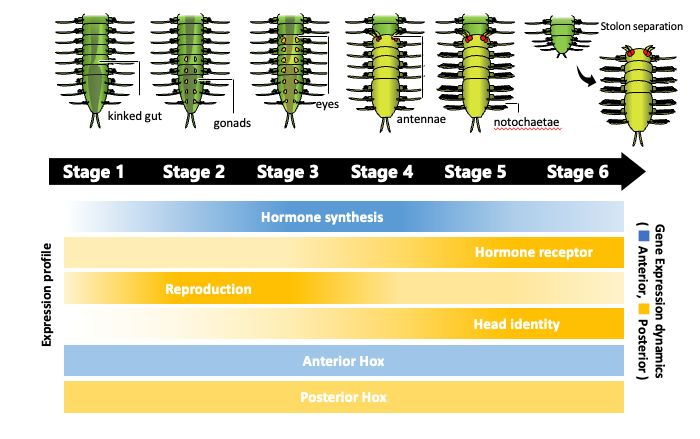Life is full of surprises, one of which is how some worms have a unique way of having babies. Benthic annelids belonging to the family Syllidae (Annelida, Errantia, Phyllodocida) exhibit a unique reproduction mode called “schizogamy” or “stolonization,” in which the posterior body part filled with gametes detaches from the original body, as a reproductive unit (stolon) that autonomously swims and spawns.
Stolons are solitary swimmers that spawn when they come into contact with other sexes. Not only would swimming shield the original body from environmental threats, but it might also facilitate the gametes’ more extensive dispersal.
For a long time, experts have been puzzled by the mystery behind the stolon’s head’s development within the original body. This fascinating phenomenon has finally been explained by Professor Miura’s research, which is motivated by a deep interest in the evolutionary transitions of developmental processes in animal life cycles.
This study carried out morphological and histological observations on the developmental processes during stolonization in Megasyllis Nipponica. The observations revealed that the stolon formation starts with the maturation of gonads in the posterior end.

Afterward, a head forms in the growing stolon’s anterior region. Soon after, sensory organs like eyes and antennae develop, along with swimming bristles. It develops nerves and a “brain” to detect and act independently before the stolon separates.
Scientists investigated the developmental gene expression patterns of sexually maturing worms. The head region of different animals is defined by a well-known collection of genes involved in head formation. According to scientists, the head area of the stolon is where these genes express themselves more. In general, head formation genes are not represented to the same extent in the middle regions of the body. However, head formation genes are highly expressed at the middle of the posterior end of the original body during gonad development in syllids.
Professor Toru Miura from the University of Tokyo said, “This shows how normal developmental processes are modified to fit the life history of animals with unique reproductive styles.”
“Hox genes determine the body segmentation along the syllids’ body. Miura and team thought that those genes would be expressed differently along the anterior-posterior axis. Interestingly, the expressions of Hox genes that determine body-part identity were constant during the process.”
“As a result, the stolons lack differentiated digestive tract and have repeated uniform body segments (except for the head and tail). “This indicates that only the head part is induced at the posterior body part to control spawning behavior for reproduction.”
“The study not only revealed the developmental mechanism of stolons for the first time but also sparked further inquiry into the intricacies of this bizarre reproductive method. We want to clarify the sex determination mechanism and the endocrine regulations underlying the reproductive cycles in syllids.”
Journal Reference:
- Mayuko Nakamura, Kohei Oguchi, Daisuke S. Sato, Sumika Kato, Masanori Okanishi, Yoshinobu Hayashi, M. Teresa Aguado, Toru Miura. 2023. Morphological, Histological and Gene-Expression Analyses on Stolonization in the Japanese Green Syllid, Megasyllis nipponica (Annelida, Syllidae). Scientific Reports. DOI: 10.1038/ s41598-023-46358-8
